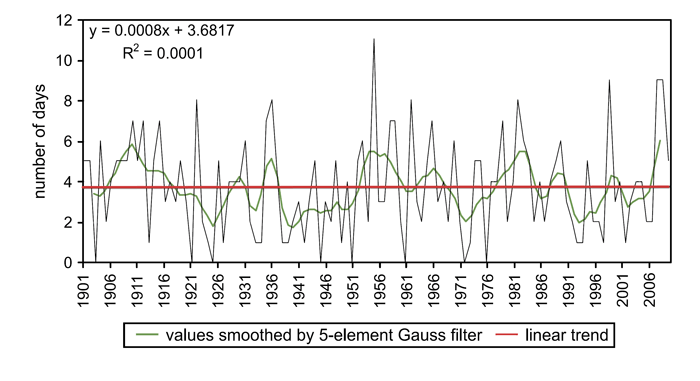Reference
Bielec-Bakowska, Z. and Piotrowicz, K. 2013. Long-term occurrence, variability and tracks of deep cyclones over Krakow (Central Europe) during the period 1900-2010. International Journal of Climatology 33: 677-689.
Background
The authors write that "at a continental scale it is low pressure areas, especially those traveling from west to east with their associated systems of atmospheric fronts, that generally have a significant influence on European weather," as they are "often accompanied by meteorological phenomena of a violent nature, such as sudden changes of pressure and temperature, strong winds, heavy precipitation including hail, and electrical discharges," with the result that "very often these phenomena cause considerable damage to the environment and the economy and may adversely influence human health and well-being." And they add that "at a time of ongoing debate about climate change and the impact of human activities, questions have been asked whether a further increase in the frequency and intensity of similar events might be expected in the near future."
What was done
In an attempt to provide a well-founded data-based answer to this important question, Bielec-Bakowska and Piotrowicz analyzed the frequency of occurrence of air pressure values equal to or lower than the 1st percentile (equivalent to ≤ 995.3 hPa) of all air pressure values recorded at 12:00 UTC in Krakow, Poland, over a period of 110 years (1900/1901-2009/2010), with "special attention" being devoted to the tracks of deep cyclones.
What was learned
The two Polish researchers report that the frequency of deep cyclones in Poland, both overall and in each of a number of specific track groups, "failed to change significantly" over the 110-year period of their study (see the figure below). In the most important of these groups, which was composed of "more than half of all deep cyclones," they found that they "developed over the Atlantic and travelled over or near Iceland via the Baltic Sea and/or the Scandinavian Peninsula," and that "towards the end of the study period, it was observed that deep cyclones following these tracks shortened their journeys considerably," due to the fact that "as they moved over the Scandinavian Peninsula or the Baltic Sea, they 'suddenly' weakened and filled up."

Long-term variability of the number of days with deep cyclones (≤ 995.3 hPa) in Krakow, Poland over the period 1900-2010. Adapted from Bielec-Bakowska and Piotrowicz (2013).
What it means
In the concluding paragraph of their paper, Bakowska and Piotrowicz thus write that their study "failed to clearly confirm any increase in the frequency of particularly deep cyclones," which means, in their words, that "forecasts envisaging higher frequencies of strong winds accompanying deep cyclones must be treated with caution."




